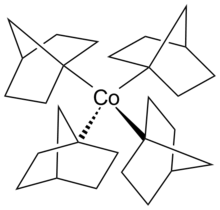Metal tetranorbornyl
In organometallic chemistry, metal tetranorbornyls are compounds with the formula M(nor)4 (M = a metal in a +4 oxidation state) (1-nor = 4bicyclo[2.2.1]hept-1-yl) and are one of the largest series of tetraalkyl complexes derived from identical ligands.[1][2] Metal tetranorbornyls display uniform stoichiometry, low-spin configurations, and high stability, which can be attributed to their +4 oxidation state metal center. The stability of metal tetranorbornyls is predominately considered to be derived from the unfavorable β-hydride elimination. Computational calculations have determined that London dispersion effects significantly contribute to the stability of metal tetranorbornyls. Specifically, Fe(nor)4 has a stabilization of 45.9 kcal/mol−1. Notable metal tetranorbornyls are those synthesized with metal centers of cobalt, manganese, or iron.[3]
Preparation[edit]
Traditionally, metal tetranorbornyls are prepared by a reaction of alkyllithiums, such as 1-norbornyllithium, with transition-metal halides while tumbling with glass beads in pentane. This is followed by a filtration step using a column of alumina to remove pentane byproducts. Lastly, a recrystallization step from pentane to obtain the crystalline compound.[1]
Alternative methods for the preparation of metal tetranorbornyls have been proposed. Specifically, the tetrakis(1-norbornyl)chromium complex can be prepared in inert atmosphere conditions with 1-norbornyllithium dissolved in hexane. An addition of CrCl3(THF)3 is made and allowed to stir for 48 hours. After, the solution is centrifuged for the removal of LiCl. The resulting supernatant is applied to an alumina column with hexane being used as the elution solvent. The use of the alumina column allows for the collection of a purple fraction that undergoes solvent evaporation and sublimation to obtain the desired Cr(nor)4 complex.[4]
The tetrakis(1-norbornyl)cobalt(IV) complex can be prepared by the following:
- CoCl2·THF + 4norLi → [pentane] [Co(nor)4] + CO + 4 LiCl + 2THF[5]

1-norbornyllithium
The tetrakis(1-norbornyl)molybdenum(IV) complex was prepared by William M. Davis, Richard R. Schrock, and Richard M. Kolodziej by the following:
- MoCl3(THF)3 + 4norLi → [Ether/ THF (30/1)] Mo(nor)4[6]
The MoCl3(THF)3 was stirred with 1-norbornyllithium in a mixture of THF and diethyl ether at . The reaction mixture was then warmed to and after approximately 90 minutes it was observed as a red color with a blue precipitate. The reaction mixture was then filtered to remove the blue precipitate. The red filtrate was then reduced via a vacuum to yield red crystals of Mo(nor)4.[6]
Structure and bonding[edit]
The stability of metal tetranorbornyls is generally considered to be a result of unfavorable β-hydrogen elimination. Metal alkyl species with β-hydrogen atoms present on the alkyl group are disfavored due to β-hydrogen migration to the metal center, which results in an olefin being eliminated and the production of the corresponding metal hydride. 1-norbornyl does not undergo β-hydrogen migration even though it possesses 6 β-hydrogen atoms due to the unfavorable formation of the olefin, 1-norbornene. According to Bredt's rule, one of the sp2 carbons of the double-bonded carbon atoms would be located at the bridgehead, which would cause 1-norbornene to be highly strained.[7] β-hydrogen elimination does not explain the formation of metal tetranorbornyls complexes that are synthesized from lower valent metal center precursors, shortened bond lengths between the metal center and 1-norbornyl ligand carbons, or the resulting low-spin tetrahedral molecular geometry.[1][3]

Unfavorable β-hydrogen migration resulting in the formation of 1-norbornene from a 1-norbornyl metal complex[7]
Quantum mechanical calculations have elucidated that London dispersion forces between the norbornyl ligands are accountable for the stability and molecular geometry of the homoleptic tetranorbornyl metal complexes.[3][7]
Metal tetranorbornyls complexes consisting of the divalent and trivalent metal center species of Cr, Mn, Fe and Co halides undergo formation of negatively charged complexes followed by oxidation that is induced by other transition-metal species in the reaction. Factors that lead to disproportionation are traditionally considered to be derived from the tertiary carbanion ligand, 1-norbornyllithium, and the lack of potential for the pentane solvent to act as a ligand. Therefore, metal tetranorbornyls composed of first-row transition metals are not accessible to be penetrated by small reagents due to the metal center's coordination sphere.[1]
Tetrakis(1-norbornyl)cobalt(IV)[edit]
Tetrakis(1-norbornyl)cobalt(IV) is a thermally stable homoleptic complex observed with σ-bonding ligands. The metal tetranorbornyl complex was the first isolated low-spin complex with tetrahedral molecular geometry. The tetrakis(1-norbornyl)cobalt(IV) complex was first synthesized by Barton K. Bower and Howard G. Tennent in 1972.[1][8][9]
The tetrakis(1-norbornyl)cobalt(IV) oxidation state is a reversible reaction using O2 as the oxidizing agent.[10] The coordination environment of the cobalt metal center has a distorted tetrahedron structure. When examined by x-ray crystallography, the metal tetranorbornyl has a crystallographic Cs symmetry due to the presence of six carbons laid on the mirror plane. However, the four carbons atoms bonded to the cobalt metal center resembled a tetragonally compressed tetrahedron, which appeared as a pseudo D2d symmetry.
The cobalt metal center in the +4 oxidation state has a d5 configuration.[11] Typically, the d5 configuration is expected to result in the high spin complex containing 5 unpaired electrons and only 1 unpaired electron in the low spin tetrahedral complex. The single unpaired electron resides in the antibonding t2 orbital, which would cause the structure to experience a Jahn-Teller distortion. However, Theopold and co-workers speculated that the slight tetragonal compression could have been a result of steric interactions between norbornyl ligands and crystal packing forces.[10]
Tetrakis(1-norbornyl)iron(IV)[edit]
The tetrakis(1-norbornyl)iron(IV) complex was first synthesized by Barton K. Bower and Howard G. Tennent in 1972.[1] The 1-norbornyl ligands on the complex have a strong dispersion attraction and high ring strain, which as a consequence hinders the α- and β-hydride elimination reactions. Additionally, the identical ligands cause a reduced chemical reactivity due to a crowded chemical environment that impedes the interaction of small molecules with the Fe-C bonds.[12]
Synthesized complexes[edit]
Barton K. Bower and Howard G. Tennent were able to successfully synthesize and characterize the following metal tetranorbornyls derived from the first-, second-, and third-row transition metals:[1]
- tetrakis(1-norbornyl)hafnium
- tetrakis(1-norbornyl)zirconium
- tetrakis(1-norbornyl)titanium
- tetrakis(1-norbornyl)vanadium
- tetrakis(1-norbornyl)chromium
- tetrakis(1-norbornyl)manganese
- tetrakis(1-norbornyl)iron
- tetrakis(1-norbornyl)molybdenum
The metal tetranorbornyls complexes of hafnium, zirconium, titanium, and vanadium display a tetrahedral molecular geometry, which is analogous to the tetrachloride form of the metals. In comparison, the cobalt, manganese, and iron complexes display a tetragonal molecular geometry.[1] A combination of London dispersion force and steric effects from the 1-norbornyl ligands results in the stability observed for the metal center.[3]
Characterization[edit]
Magnetic measurements[edit]
The resulting molecular geometry of the metal tetranorbornyls complexes is due to the unpaired and paired d electrons. Magnetic measurements have indicated that the d electrons of tetrakis(1-norbornyl)chromium (d2) and tetrakis(1-norbornyl)manganese (d3) are not spin paired. The four d electrons of tetrakis(1-norbornyl)iron and tetrakis(1-norbornyl)cobalt are spin paired.[1]
Electron paramagnetic resonance spectroscopy[edit]
Metal tetranorbornyls are commonly characterized via electron paramagnetic resonance (EPR) spectroscopy. Tetrakis(1-norbornyl)molybdenum was observed as a room temperature EPR signal that originated from a d2 metal center, which was considered to have two unpaired electrons in the eg orbital. In addition, the resulting EPR signal of tetrakis(1-norbornyl)chromium was comparable.[6][13]
Cyclic voltammetry[edit]
In 1988, Klaus H. Theopold and Erin K. Byrne performed the electrochemical experiment, cyclic voltammetry, to determine how oxidizing was the metal center of the tetrakis(1-norbornyl)cobalt(IV) complex. Two reversible electron transfer waves at -0.65 and -2.02 V were observed in THF, which elucidated that the difference in peak potentials were consistent with two one-electron transfer processes when being compared to the ferricenium/ ferrocene couple.[5] In the same year, William M. Davis, Richard R. Schrock, and Richard M. Kolodziej produced a cyclic voltammogram for tetrakis(1-norbornyl)molybdenum. Two oxidation waves were observed at -0.15 and +1.25 V in DCM. The oxidation at -0.15 V was considered to be reversible. In comparison, the second oxidation at +1.25 V was considered to be irreversible.[6]
References[edit]
- ^ a b c d e f g h i Bower, Barton K.; Tennent, Howard G. (April 1972). "Transition metal bicyclo[2.2.1]hept-1-yls". Journal of the American Chemical Society. 94 (7): 2512–2514. doi:10.1021/ja00762a056. ISSN 0002-7863.
- ^ Abrahamson, Harmon B.; Brandenburg, Kathryn L.; Lucero, Barbara; Martin, Mary E.; Dennis, Eleonore (September 1984). "Spectroscopy and photochemistry of the tetranorbornyl complexes of titanium and chromium". Organometallics. 3 (9): 1379–1386. doi:10.1021/om00087a010. ISSN 0276-7333.
- ^ a b c d Liptrot, David J.; Guo, Jing‐Dong; Nagase, Shigeru; Power, Philip P. (2016-11-14). "Dispersion Forces, Disproportionation, and Stable High‐Valent Late Transition Metal Alkyls". Angewandte Chemie International Edition. 55 (47): 14766–14769. doi:10.1002/anie.201607360. ISSN 1433-7851. PMID 27778428.
- ^ Brandenburg, Kathryn Lynn. Photoinduced reactions of group VI organotransition metal complexes. OCLC 83966357.
- ^ a b Byrne, Erin K.; Theopold, Klaus H. (February 1987). "Redox chemistry of tetrakis(1-norbornyl)cobalt. Synthesis and characterization of a cobalt(V) alkyl and self-exchange rate of a Co(III)/Co(IV) couple". Journal of the American Chemical Society. 109 (4): 1282–1283. doi:10.1021/ja00238a066. ISSN 0002-7863.
- ^ a b c d Kolodziej, R. M.; Schrock, R. R.; Davis, W. M. (1988-12-27). "ChemInform Abstract: Synthesis and Characterization of Mo(nor)4 (nor: 1-Norbornyl)". ChemInform. 19 (52). doi:10.1002/chin.198852222. ISSN 0931-7597.
- ^ a b c "Dispersion Effects in Stabilizing Organometallic Compounds: Tetra-1-norbornyl Derivatives of the First-Row Transition Metals as Exceptional Examples". doi:10.1021/acs.jpca.9b06769.s001. Retrieved 2023-03-12.
{{cite journal}}: Cite journal requires|journal=(help) - ^ Byrne, Erin K.; Richeson, Darrin S.; Theopold, Klaus H. (1986). "Tetrakis(1-norbornyl)cobalt, a low spin tetrahedral complex of a first row transition metal". Journal of the Chemical Society, Chemical Communications (19): 1491–1492. doi:10.1039/c39860001491. ISSN 0022-4936.
- ^ Byrne, Erin K.; Theopold, Klaus H. (May 1989). "Synthesis, characterization, and electron-transfer reactivity of norbornyl complexes of cobalt in unusually high oxidation states". Journal of the American Chemical Society. 111 (11): 3887–3896. doi:10.1021/ja00193a021. ISSN 0002-7863.
- ^ a b Byrne, Erin K.; Richeson, Darrin S.; Theopold, Klaus H. (1986). "Tetrakis(1-norbornyl)cobalt, a low spin tetrahedral complex of a first row transition metal". Journal of the Chemical Society, Chemical Communications (19): 1491. doi:10.1039/c39860001491. ISSN 0022-4936.
- ^ Green, Malcolm L. H.; Parkin, Gerard (2014-04-28). "Application of the Covalent Bond Classification Method for the Teaching of Inorganic Chemistry". Journal of Chemical Education. 91 (6): 807–816. Bibcode:2014JChEd..91..807G. doi:10.1021/ed400504f. ISSN 0021-9584.
- ^ Li, Huidong; Wang, Linshen; Hu, Yucheng; Zhang, Ze; Wan, Di; Fan, Qunchao; King, R. Bruce; Schaefer, Henry F. (2020-08-27). "Comparative Study of the Thermal Stabilities of the Experimentally Known High-Valent Fe(IV) Compounds Fe(1-norbornyl) 4 and Fe(cyclohexyl) 4". The Journal of Physical Chemistry A. 124 (34): 6867–6876. Bibcode:2020JPCA..124.6867L. doi:10.1021/acs.jpca.0c04055. ISSN 1089-5639. PMID 32786998. S2CID 221127617.
- ^ Ward, G. A.; Bower, B. K.; Findlay, M.; Chien, James C. W. (1974-05-07). "ChemInform Abstract: Electron Paramagnetic Resonance of Tetrakis(1-norbornyl)Chromium". Chemischer Informationsdienst. 5 (18). doi:10.1002/chin.197418348. ISSN 0009-2975.





